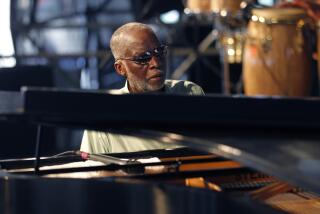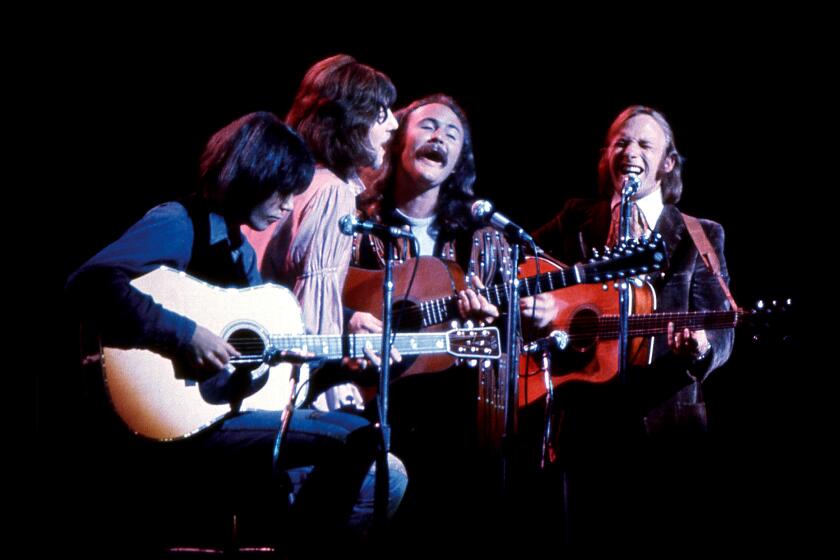Recalling a Master of Violin Versatility
- Share via
His elegant, Old World demeanor was the first thing one noticed about Stephane Grappelli. In an art that has sometimes been given to visual and aural excess, the veteran French jazz violinist had the look of a sweet but rakish grandfather. With a smile as captivating as that of Maurice Chevalier and a luminous, almost ecstatic involvement with his music, Grappelli--who died in Paris on Monday at the age of 89--was a walking advertisement for the sheer joy of playing jazz.
The violin has never been a particularly popular instrument for jazz players. There was a belief in jazz at one time that the physical nature of violin bowing made it almost impossible to play the instrument with the crisp articulation necessary for jazz swing. But for Grappelli (as well as such compatriots as Stuff Smith, Joe Venuti, Eddie South and Ray Nance) the violin was capable of the full range of jazz expression. He chose it, he said, because there was “not too much competition,” but his equally captivating piano playing confirmed the depth of his artistry, regardless of his choice of how to voice it.
In Grappelli’s hands the violin became a vehicle for an irresistibly appealing range of jazz music. Playing ballads with a lush, rhapsodic yearning, he easily shifted gears when he moved into up-tempos, driving his improvised lines with a foot-tapping flow of swing.
And he was adaptable--completely receptive to the changing tides of jazz. Like tenor saxophonist Coleman Hawkins, another musician with great artistic pliability, he was fully capable of playing with almost anyone, so long as the chord changes were there and the rhythm section was swinging.
How versatile was he? Consider this: With only brief formal training at the Paris Conservatory in the mid-’20s, he became one of the principals--alongside legendary guitarist Django Reinhardt--in the superb Quintette Du Hot Club De France in 1934.
His partnership with Reinhardt was a stunning breakthrough, for many the first evidence that jazz could travel, that musicians from other countries could use it as a voice for their own cultural expression. Inescapably European in its sense of urban sophistication (Grappelli’s contribution), mixed with an undercurrent of Gypsy passion (from Reinhardt), the Grappelli-Reinhardt sound became one of the distinctive jazz expressions of the pre-bop era.
Over the next 60 years, Grappelli worked with a genre-bending array of musicians: Among the pianists, there were the swing era’s Earl Hines, bop-based stylists such as George Shearing, Hank Jones and Oscar Peterson, as well as definitive post-bop pianist McCoy Tyner; a list of his guitarist associates, in addition to Reinhardt, included Barney Kessel, Joe Pass and Larry Coryell. And, just for good measure, Grappelli got together with mandolinist David Grisman, cellist Yo-Yo Ma and harmonica player Toots Thielemans.
No matter the setting, however, Grappelli’s approach was constant. And the constancy of his style remained until the very end. “I will play,” he once said, “until the final curtain.”
And he did just that. At his most recent Southland appearances in the early ‘90s, Grappelli performed music with the classic beauty and propulsive swing that have always characterized his playing. He may have looked a bit infirm and been obliged to make the concession of playing while seated, but nothing in his playing suggested anything other than the vigor of complete creativity. Watching him in those final years, a cherubic smile crossing his face, his precise, articulate bow drawing magic from his violin strings, was one of the great pleasures of hearing jazz.
* OBITUARY: Stephane Grappelli dies in Paris at age 89. Main news section.
More to Read
The biggest entertainment stories
Get our big stories about Hollywood, film, television, music, arts, culture and more right in your inbox as soon as they publish.
You may occasionally receive promotional content from the Los Angeles Times.









